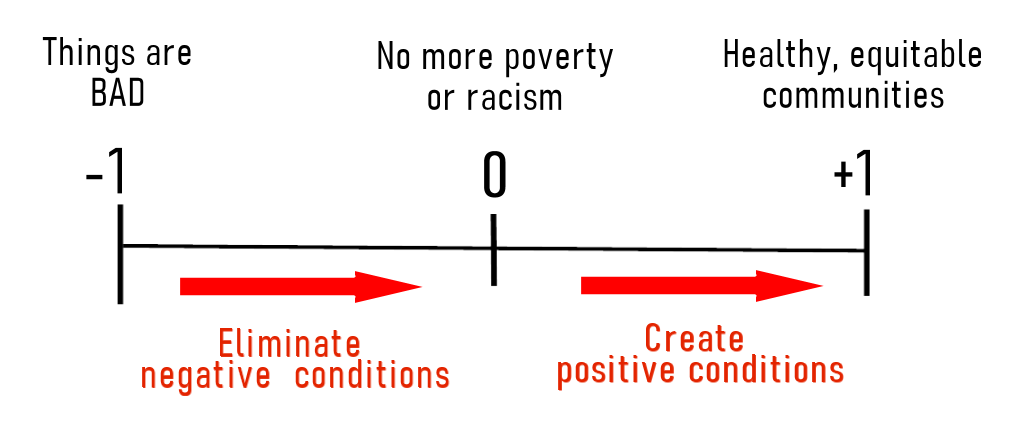Current e-Journal
-

January 25, 2021

for your community?
for your world?
for yourself?
Before we dive in, a quick announcement:
You can influence what you read in this newsletter.
As we step more deeply into systems change work here at Creating the Future, we want your ideas about making this eJournal as useful for you as possible. Let us know your thoughts at this link. Or be part of the conversation that will happen this Wednesday, January 27, at 12noon Pacific time / 3pm Eastern time. We really want your ideas and insights, so please let us know! Click here
Keeping Your Eye on the Prize – a Healthy, Equitable World
Even as we’ve started a new year filled with hope, it is easy to lose ourselves in the sea of what is wrong. The pandemic. Systemic racism, sexism, ableism, and general “otherism.” Environmental degradation. Attacks on the rights of LGBTQ people to live freely as full citizens. The list is long.
As changemakers, it is easy to see the elimination of any of those problems as your primary goal. Imagine a world without poverty, or racism, or climate change, or… Sounds pretty wonderful, right?
Not so fast.
Catalytic Thinking reminds us that eliminating a bad situation is not the same as creating a good situation. Because the most potent predictor of success is where we aim, when we aim at “eliminating a negative condition” as our ultimate goal, we are setting ourselves up to always fall short of our true potential for change.
Hildy frequently explains this seemingly counter-intuitive predicament with mathematics, reminding us that eliminating a negative number (adding +1 to -1) doesn’t create a positive number; it gets us to zero. What we really want is that positive condition beyond the total elimination of our problems – what the elimination of those problems could make possible. But that’s not where we aim. We aim short of that.

In reality, we typically aim far short of that, as we believe that eliminating racism or poverty is too lofty to be a real goal. The result? We aim at “less bad” as if it were the same as “good.” Less poverty. Less discrimination. Less environmental harm.
Led by strategic planning methods that encourage us to aim at what is quickly achievable and fundable vs. what is possible for our communities, the social change arena really has set ourselves up to achieve far less than our potential.
But…
We can do better. We can broaden our focus to aim for what we really want, the positive state that lies beyond our problems. We will then solve our problems on the way to creating equity and health for our planet and all beings who live here.
This new year, let's recommit to just that. Let’s solve these systemic problems, by keeping our eye firmly on the REAL prize - the world we really want.
Try this
This year, aim squarely at what you really DO want. These few steps will help you keep that powerful, positive goal as your True North.
Step 1: What do you really want?
Answer that question as it relates to the conditions you want to see in the world (or in your community, or in your life). What would people feel and see in the world you want to create? What would your community look and sound like? How would people feel? What would be present?
Step 2: Test your answer
To determine if you are really aiming at a positive goal, test your words. Are they in any way negative or reactive?
Ending… Eliminating… Stopping… Getting beyond…
Those words may feel positive, but they are actually reacting to what is wrong. Creative words have a forward thrust, focusing on what things WILL look like vs. labeling what we do NOT want to see.
Step 3: Try again
If your answers were about ending this or that, ask this question
“If we ended poverty / racism / substance abuse – what would that make possible for our community? What would that make possible for people who used to be dealing with those situations?"
Keep asking about what is possible until you can feel that positive goal pulling you forward. An equitable world, where everyone has the opportunity to live the life they dream of. A peaceful world, where trust is the norm, and people routinely listen and learn from those with whom they don’t agree. A joyful world, where each of us has what we need to reach for our potential.
Step 4: Hold that potential as your true north.
In a piece about her family, Hildy shared the story of settling her mother's estate. What was her “True North” goal? To have an ongoing, loving relationship with her brother, lasting far into the future, even if they disagreed about the estate. That goal didn’t eliminate the need to sell a house or settle finances. But it did provide a guiding light as issues arose.
Aiming at a healthy, safe, equitable community can only happen when we solve problems NOT as the ultimate goal, but as a step towards what we really want. When we aim at less than that, we sell ourselves short, seeing only a portion of the story. The rest of the story – our potential for creating what has not existed before – that is our superpower. The smart phone. The moon landing. The only way humanity has stretched to accomplish anything remarkable is by seeing the “impossible” as possible. Through that lens, there is no end to what we can accomplish.
So keep that potential in view. Make it the topic of staff meetings (“What evidence have you seen of our vision in action?”). Make it the headline of your annual reports, your newsletters, your tag line. Create that potential as your context, for 2021 and beyond.
And remember:
Unless something is physically impossible, it is possible.
That bigger context, including not just our problems, but our potential – the whole math line, not just the negative side – that is our superpower. And it is what makes Catalytic Thinking catalytic.
Want to learn alongside other people who are also trying out Catalytic Thinking practices? Join our Catalytic Thinking in Action community on Facebook - a welcoming place where you can ask questions and learn from people like you who are experimenting with these practices. We look forward to seeing you there!
Help Keep Our Programs Freely Available
Most of the programs at Creating the Future are free or low cost, with liberal tuition assistance when they aren’t.
If you find our programs of benefit, we hope you will consider contributing, to help keep these programs available to as many people as possible. Donate here ...
eJournal Archives:
If you’re new to our eJournal, or just want to remind yourself of past practice exercises we’ve shared, check out our eJournal archives here.
SUBSCRIBE
to get this e-Journal
Creating the Future is a 501(c)(3) tax exempt organization in the U.S.A


